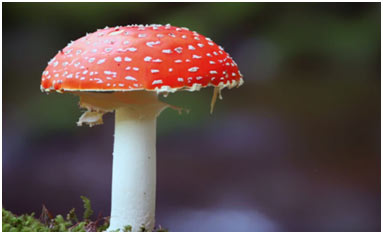Fungi – The Recyclers
Round about 100,000 species of organisms called “fungus” are known and a lot more are estimated to be present.
This group consists of well-known pathogens such as disastrous rusts, smuts of wheat and corn, and molds found growing on important crops and foodstuffs.
Delicacies such as mushrooms, truffles, and morels, and other organisms of industrial use such as Penicillium – the source of the antibiotic penicillin, and the yeasts – used in bakeries and breweries are likewise members of this group.
The ecological function of fungi as decomposers is paralleled just by bacteria.
- 1) Taxonomic status of fungi
- 2) Body of Fungi
- 3) Might it be the world’s largest organism???
- 4) Nutrition in Fungi
- 5) Mutualistic Symbiotic Associations in Fungi
- 6) Growth of Fungi
- 7) Multiple-Choice Questions (MCQs) with Answers
- 8) FAQs (Frequently Asked Questions) – Fungi Tutorial
- 9) Summary: Exploring the Kingdom of Fungi
Taxonomic status of fungi
The taxonomic status of fungi has actually altered from that of ‘a group of Plant kingdom’ to a different kingdom “Fungi”. They resemble plants in some aspects – have a cell wall, lack centrioles, and are non-motile. But fungi resemble more animals than plants.
Unlike plants and like animals, fungi are heterotrophs, lack cellulose in their cell wall and include chitin – the chemical present in the external skeleton of arthropods. For this reason, some mycologists (scientists who study fungi) think that fungi and animals most likely emerged from a common ancestor. However, fungi are different from animals in having a cell wall, being absorptive heterotrophs, and non-motile. So, fungi are neither plants nor animals.
Their DNA studies also confirm that they are different from all other organisms. They show a characteristic kind of mitosis, called ‘nuclear mitosis’. During nuclear mitosis, the nuclear envelope does not break; rather the mitotic spindle kinds within the nucleus and the nuclear membrane constricts between the two clusters of daughter chromosomes. (In some fungi nuclear envelope dismantles late). Because fungi stand out from plants, animals, and protists in lots of methods, they are appointed to a separate kingdom ‘Fungi’.
Body of Fungi
The body of fungi, called mycelium, includes long, slender, branched tubular thread-like filaments called the hyphae (singular hypha). Hyphae spread extensively over the surface area of the substratum. Chitin in their wall is more resistant to decay than are cellulose and lignin which make up the plant cell walls.
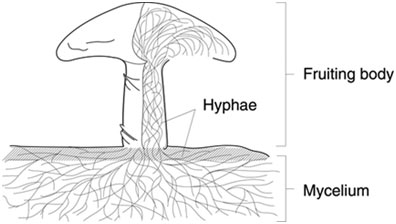
Hyphae might be septate or non-septate. Septate hyphae are divided by cross-walls called septa (particular septum) into individual cells consisting of one or more nuclei. Non-septate hyphae lack septa and are not divided into individual cells; instead, these are in the type of an extended multinucleated large cell. Such hyphae are called coenocytic hyphae, in which the cytoplasm moves effectively, distributing the products throughout.

Septa of lots of septate fungi have a pore through which cytoplasm flows from cell to cell, carrying the products to growing ideas and making it possible for the hyphae to proliferate when food and water are plentiful and the temperature level is favorable. All parts of fungus growing through the substrate are metabolically active. An extensive spreading system of hyphae supplies a huge surface area for absorption.
Hyphae may be packed together and organized to form complex reproductive structures such as mushrooms, puffballs, morels and so on which can expand rapidly. Yeast is non-hyphal unicellular fungi. All fungal nuclei are haploid except for short-term diploid zygote that forms during sexual reproduction.
Might it be the world’s largest organism???
A circular clone of Armillaria, a pathogenic fungus afflicting conifers, growing out from a central focus, has been measured up to 15 hectares (1hectare = 10000 m2).
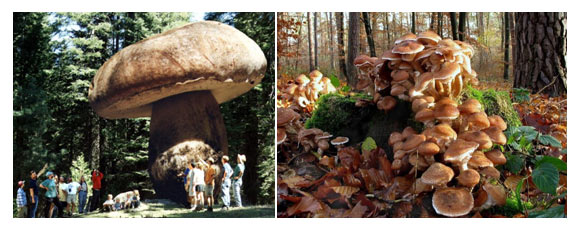
Nutrition in Fungi
All fungi lack chlorophyll and are heterotrophs (getting carbon and energy from raw material). They get their food by direct absorption from the immediate environment and are thus absorptive heterotrophs. Most fungi are saprotrophs (or saprobes), decomposers that acquire their food (energy, carbon, and nitrogen) direct from dead raw material.
They produce out digestive enzymes that digest dead organic matter, and the organic molecules hence produced are absorbed back into the fungi. Saprobic fungi anchor to the substrate by modified hyphae, the rhizoids.
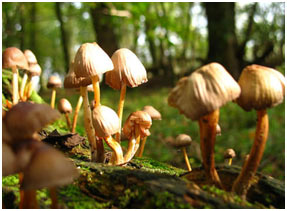
Fungi are the primary decomposers of cellulose and lignin, the primary parts of plant cell walls (most bacteria can not break them). An extensive system of fast-growing hyphae supplies massive surface for an absorptive mode of nutrition. Saprobic fungi, along with bacteria, are the significant decomposers of the biosphere, adding to the recycling of the elements (C, N, P, 0, H, etc) used by living things.
Some fungi are parasites, some are even predators, and still, others are mutualists. Parasitic fungi absorb nutrients straight from the living host cytoplasm with the help of unique hyphal tips called haustoria.
They may be obligate or facultative. Obligate parasites can grow only on their living host and can not be grown on available defined growth culture medium. Different mildews and most rust species are obligate parasites. Facultative parasites can grow parasitically on their host as well as by themselves on artificial growth media.
Some fungi are active predators. The oyster mushroom (Pleurotus ostreatus) is an omnivorous (predatory) fungus. It paralyzes the nematodes, penetrates them, and absorb their dietary contents, primarily to fulfill its nitrogen requirements. It fulfills its glucose requirements by breaking the wood. Some types of Arthrobotrys trap soil nematodes by forming a restricting ring, their hyphae invade and absorb the unlucky victim. Other predators have other adaptations, such as secretion of sticky compounds.
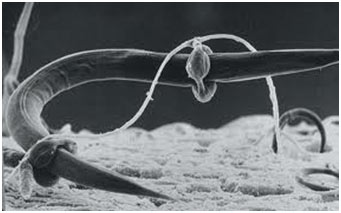 and desiccation and itself gets food through the courtesy of alga
and desiccation and itself gets food through the courtesy of alga
Mutualistic Symbiotic Associations in Fungi
Fungi form two major mutualistic symbiotic associations (associations of benefit to both partners). These are lichens and mycorrhizae.
Lichens
Lichens are mutualistic symbiotic associations between particular fungi (mainly Ascomycetes and imperfect fungi, and few Basidiomycetes – about 20 out of 15000 species of lichens) and certain photoautotrophs-either green algae or a cyanobacterium, or some times both.
The majority of the visible part of a lichen consists of fungus, and algal components are present within the hyphae. Fungus protects the algal partner from strong light and desiccation and itself gets food through the courtesy of alga.
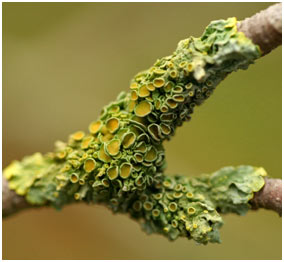
Lichens can grow at such locations where neither of the components alone can, even in harsh areas such as bare rocks and so on. Lichens differ in color, shape, total look, growth form. They are environmentally extremely important as bioindicators of air pollution.
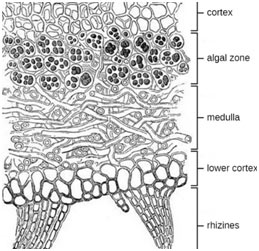
Mycorrhizae
Mycorrhizae are mutualistic association between particular fungi and roots of vascular plants (about 95% of all kinds of vascular plants). The fungal hyphae significantly increase the amount of soil contact and overall area for absorption and aid in the direct absorption of phosphorus, zinc, copper, and other nutrients from the soil into the roots. Such plants reveal better development than those without this association. The plant, on the other hand, supplies natural carbon to fungal hyphae.
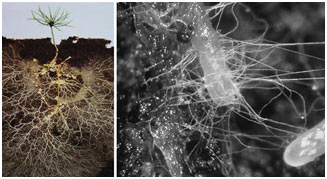
There are two primary types of mycorrhizae: endomycorrhizae, in which the fungal hyphae permeate the external cells of the plant root, forming coils, swellings, and minute branches, and also extend out into surrounding soil; and ectomycorrhizae, in which the hyphae surround and extend between the cells however do not permeate the cell walls of the roots. These are primarily formed with pines, firs, etc. However, the mycelium extends far out into the soil in both sorts of mycorrhizae.
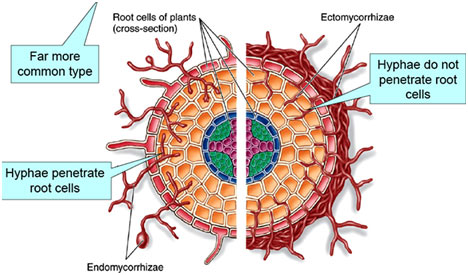
Growth of Fungi
Fungus grows best in damp environments, however, are discovered anywhere raw material is present. They endure dry conditions in some resting stage or by producing resistant spores. They can also endure a large range of pH from 2 – 9, a broad temperature range, and high osmotic pressure such as in concentrated salt/sugar solutions as in jelly, jam, etc. These features also help them in their survival on land. Fungi store surplus food generally as lipid droplets or glycogen in the mycelium.
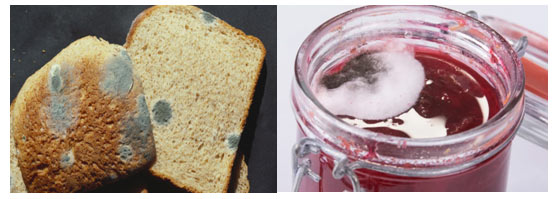
Multiple-Choice Questions (MCQs) with Answers
- What is the estimated number of known fungal species?
- a) 50,000
- b) 100,000
- c) 150,000
- d) 200,000
- Answer: b) 100,000
- Which kingdom did fungi belong to before being classified as a separate kingdom?
- a) Animalia
- b) Plantae
- c) Protista
- d) Fungi were always a separate kingdom
- Answer: b) Plantae
- What characteristic distinguishes fungi from plants?
- a) Presence of chlorophyll
- b) Lack of cellulose in the cell wall
- c) Non-motility
- d) All of the above
- Answer: b) Lack of cellulose in the cell wall
- What is the body of fungi called?
- a) Mycelium
- b) Hyphae
- c) Rhizoids
- d) Lichens
- Answer: a) Mycelium
- What is the main component of the fungal cell wall that makes it resistant to decay?
- a) Cellulose
- b) Lignin
- c) Chitin
- d) Rhizoids
- Answer: c) Chitin
- Which type of hyphae lacks septa and is not divided into individual cells?
- a) Septate hyphae
- b) Non-septate hyphae
- c) Coenocytic hyphae
- d) Rhizoids
- Answer: c) Coenocytic hyphae
- What is the characteristic type of mitosis observed in fungi?
- a) Binary fission
- b) Budding
- c) Nuclear mitosis
- d) Conjugation
- Answer: c) Nuclear mitosis
- Which fungus is known as an omnivorous (predatory) fungus?
- a) Penicillium
- b) Rhizopus
- c) Pleurotus ostreatus
- d) Arthrobotrys**
- Answer: c) Pleurotus ostreatus
- What is the primary mode of nutrition for most fungi?
- a) Photosynthesis
- b) Absorptive heterotrophy
- c) Ingestion
- d) Decomposition
- Answer: b) Absorptive heterotrophy
- Which association is formed between fungi and roots of vascular plants?
- a) Lichens
- b) Mycorrhizae
- c) Rhizoids
- d) Haustoria
- Answer: b) Mycorrhizae
- What is the primary function of haustoria in fungi?
- a) Anchor to the substrate
- b) Absorb nutrients from the living host
- c) Form reproductive structures
- d) Secrete digestive enzymes
- Answer: b) Absorb nutrients from the living host
- Which type of mycorrhizae has hyphae that penetrate the outer cells of plant roots?
- a) Ectomycorrhizae
- b) Endomycorrhizae
- c) Rhizoids
- d) Coenocytic mycorrhizae
- Answer: b) Endomycorrhizae
- What is the primary role of fungi in the biosphere?
- a) Photosynthesis
- b) Decomposition
- c) Predation
- d) Parasitism
- Answer: b) Decomposition
- Which fungal association is environmentally important as a bioindicator of air pollution?
- a) Mycorrhizae
- b) Rhizoids
- c) Lichens
- d) Haustoria
- Answer: c) Lichens
- What is the significance of mycorrhizal associations for plants?
- a) Protection from strong light
- b) Enhanced growth
- c) Absorption of nutrients from the soil
- d) Both b and c
- Answer: d) Both b and c
- In which environment do fungi grow best?
- a) Dry conditions
- b) High light intensity
- c) Low osmotic pressure
- d) Damp environments
- Answer: d) Damp environments
- How do fungi survive dry conditions?
- a) Budding
- b) Producing resistant spores
- c) Formation of hyphae
- d) Photosynthesis
- Answer: b) Producing resistant spores
- What is the primary storage form of surplus food in fungi?
- a) Glucose
- b) Starch
- c) Lipid droplets or glycogen
- d) Cellulose
- Answer: c) Lipid droplets or glycogen
- What is the approximate pH range in which fungi can survive?
- a) 0-7
- b) 2-9
- c) 7-14
- d) 5-10
- Answer: b) 2-9
- Which fungus has been measured up to 15 hectares and is considered one of the world’s largest organisms?
- a) Penicillium
- b) Rhizopus
- c) Armillaria
- d) Pleurotus ostreatus
- Answer: c) Armillaria
- What is the main component responsible for the resistance of the fungal cell wall to decay?
- a) Cellulose
- b) Lignin
- c) Chitin
- d) Rhizoids
- Answer: c) Chitin
FAQs (Frequently Asked Questions) – Fungi Tutorial
1. Q: What are fungi, and how many species are estimated to exist?
- A: Fungi are a diverse group of organisms, and approximately 100,000 species are known, with more yet to be discovered.
2. Q: How has the taxonomic status of fungi changed over time?
- A: Initially grouped with plants, fungi are now classified as a separate kingdom called “Fungi” due to distinct characteristics, including heterotrophy, lack of cellulose, and the presence of chitin.
3. Q: How are fungi different from both plants and animals?
- A: Fungi share some features with plants but are more similar to animals. They are heterotrophs, lack cellulose, and their DNA studies confirm their uniqueness, placing them in the kingdom “Fungi.”
4. Q: What is the body structure of fungi, and what is it composed of?
- A: The body of fungi is called mycelium, consisting of hyphae. Hyphae are long, slender, and tubular filaments, with chitin in their walls making them resistant to decay.
5. Q: What are the different types of hyphae, and how do they function?
- A: Hyphae may be septate or non-septate. Septate hyphae have cross-walls (septa), while non-septate hyphae are multinucleated. Septa have pores for cytoplasmic flow, aiding in nutrient distribution.
6. Q: How do fungi reproduce, and what is unique about their mitosis?
- A: Fungi reproduce sexually and asexually. They exhibit a characteristic form of mitosis called “nuclear mitosis,” where the nuclear envelope doesn’t break during division.
7. Q: Can fungi be considered the world’s largest organism?
- A: Yes, circular clones of pathogenic fungi like Armillaria have been measured up to 15 hectares, making them one of the world’s largest organisms.
8. Q: What is the nutritional mode of fungi, and how do they obtain their food?
- A: Fungi lack chlorophyll and are heterotrophs. They obtain food through direct absorption from the environment, primarily functioning as saprotrophs by decomposing dead organic matter.
9. Q: Are there different lifestyles among fungi, such as parasites and predators?
- A: Yes, fungi exhibit diverse lifestyles. Some are parasites, absorbing nutrients from living hosts, while others are predators, actively preying on organisms like nematodes.
10. Q: What are mutualistic symbiotic associations in fungi?
- A: Fungi form mutualistic associations, such as lichens (with algae or cyanobacteria) and mycorrhizae (with plant roots), benefiting both partners.
11. Q: Why are lichens environmentally important, and where can they grow? – A: Lichens are bioindicators of air pollution. They can grow in harsh environments, including bare rocks, where individual components alone may struggle.
12. Q: How do mycorrhizae benefit both fungi and plants? – A: Mycorrhizae enhance nutrient absorption for plants and receive natural carbon from plant roots, resulting in improved growth for both partners.
13. Q: In what conditions do fungi grow best, and how do they survive adverse environments? – A: Fungi thrive in damp environments but can survive in various conditions, including dry periods, by entering resting stages or producing resistant spores.
14. Q: How is surplus food stored in fungi, and what are the ranges of pH and temperature they can tolerate? – A: Surplus food is stored as lipid droplets or glycogen. Fungi can tolerate a broad pH range (2-9), varied temperatures, and high osmotic pressure.
Summary: Exploring the Kingdom of Fungi
In this comprehensive tutorial on fungi, we embark on a journey through their taxonomic status, unique body structures, nutritional strategies, and diverse symbiotic relationships. Let’s recap the key insights:
- Fungi – The Recyclers:
- With approximately 100,000 known species, fungi play pivotal roles as recyclers, encompassing both beneficial organisms and notorious pathogens affecting crops.
- Taxonomic Status of Fungi:
- Once considered part of the Plant kingdom, fungi now constitute a separate kingdom, distinct from plants and animals. Their unique characteristics, including chitin in cell walls and nuclear mitosis, set them apart.
- Body of Fungi:
- The fungal body, known as mycelium, comprises intricate networks of hyphae. These tubular filaments, whether septate or non-septate, form the basis for absorbing nutrients from the environment.
- Might it be the World’s Largest Organism?
- Armillaria, a pathogenic fungus, presents the intriguing possibility of being the world’s largest organism, with circular clones spanning hectares.
- Nutrition in Fungi:
- Fungi, lacking chlorophyll, are heterotrophs that absorb nutrients directly from their surroundings. Their role as saprotrophs contributes significantly to the decomposition of organic matter.
- Mutualistic Symbiotic Associations in Fungi:
- Fungi engage in crucial mutualistic associations, forming lichens (with algae or cyanobacteria) and mycorrhizae (with plant roots). These partnerships showcase the ecological importance of fungi.
- Growth of Fungi:
- Thriving in diverse environments, fungi exhibit adaptability to varying pH levels, temperatures, and osmotic pressures. Their ability to endure dry conditions and store surplus food enhances their survival on land.
In conclusion, this tutorial provides a comprehensive understanding of fungi, highlighting their ecological significance, structural diversity, and multifaceted interactions with other organisms. Exploring the world of fungi enriches our knowledge of the natural world and its intricate interconnectedness.

